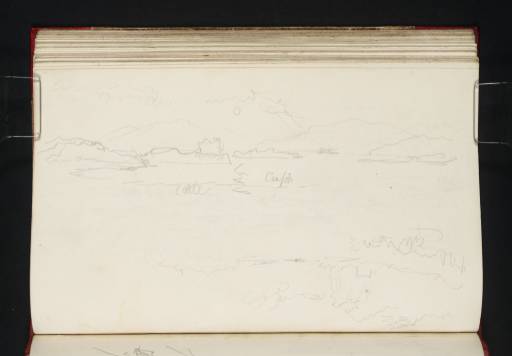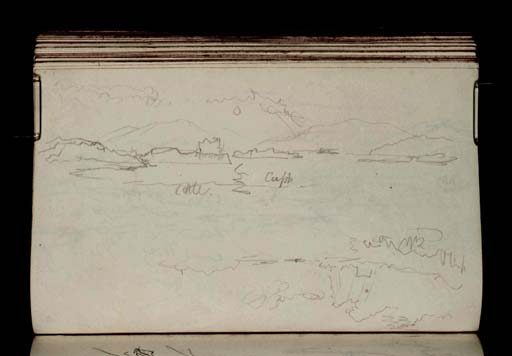J.M.W. Turner
>
1830-35 Annual tourist
>
Scotland 1831
>
Staffa Sketchbook
>
Artwork
Joseph Mallord William Turner Dunstaffnage Castle from Loch Etive; and ?Kilchurn Castle, Loch Awe 1831
Image 1 of 2
Joseph Mallord William Turner,
Dunstaffnage Castle from Loch Etive; and ?Kilchurn Castle, Loch Awe
1831
Joseph Mallord William Turner 1775–1851
Folio 82 Verso:
Dunstaffnage Castle from Loch Etive; and ?Kilchurn Castle, Loch Awe 1831
D26903
Turner Bequest CCLXXIII 82a
Turner Bequest CCLXXIII 82a
Pencil on white wove paper, 116 x 186 mm
Inscribed in pencil by Turner ?‘Castle’ [or ‘cattle’], and ‘Cuyp’ [or ‘Crofts’] centre
Inscribed in pencil by Turner ?‘Castle’ [or ‘cattle’], and ‘Cuyp’ [or ‘Crofts’] centre
Accepted by the nation as part of the Turner Bequest 1856
References
1909
A.J. Finberg, A Complete Inventory of the Drawings of the Turner Bequest, London 1909, vol.II, p.878, CCLXXIII 82a, as ‘Sound, with mountains.’.
1969
John Gage, Colour in Turner: Poetry and Truth, London 1969, pp.97, 244 note 102.
1991
David Wallace-Hadrill and Janet Carolan, ‘Turner in Argyll in 1831: Inveraray to Oban’, Turner Studies, vol. 11, no.1, Summer 1991, pp.23, 29.
1997
Martin F. Krause, Turner in Indianapolis: The Pantzer Collection of Drawings and Watercolors by J.M.W. Turner and his Contemporaries at the Indianapolis Museum of Art, Indianapolis 1997, p.182 under cat.55.
With the sketchbook held so that the fore-edge is at the top, across the top half of the page is a sketch that has been identified as Dunstaffnage Castle, as seen from Loch Etive to the east.1 The view along the loch, with the castle on a promontory at the left and with the mountains of Mull and the Morvern hills in the background, is familiar from several other pages of this book: folios 81 verso, 82, 83, 84 verso and 86 (D26901, D26902, D26904, D26907, D26910).
The inscription beneath the sketch has been interpreted differently by different writers. David Wallace-Hadrill and Janet Carolan suggest that it says ‘Black Crofts’, a village on the northern side of Loch Etive opposite, where Turner would have stood to make this sketch.2 John Gage, however, has read the second word as ‘Cuyp’, referring to the artist Aelbert Cuyp (1620–91), who Turner associated with dawn and dusk scenes, often inscribing the name to indicate a Cuypian scene, or just a yellow hue. 3 The suggestion is compelling when compared to two other sketches made during Turner’s 1831 tour of Scotland (Tate D25737; Turner Bequest CCLXV 53; and Tate D26559; Turner Bequest CCLXX 62a), both of which have the word inscribed next to a small circle showing the sun’s orb. It is also supported by further colour notes on similar sketches of Dunstaffnage on folios 81 verso and 83 (D26901, D26904) – ‘all grey’ and ‘gold’ – which indicate, according to Wallace Hadrill and Carolan, that Turner saw the scene ‘in terms of the watercolour that might result’.4 Neither writer tackled the first word which could be read as ‘Castle’, referring to Dunstaffnage, or ‘Cattle’, suggesting that Turner had seen cows near the water’s edge in the foreground of the picture. ‘Cattle’ would be consistent with the ‘Cuyp’ reading, as the Dutch master often painted cows in the foreground of his pictures.
In addition to the setting sun (which is reflected in the water of the loch beneath), the clouds and a diagonal line to their right may indicate rain, which is also shown in a similar view at the top of folio 86 (D26910). Wallace-Hadrill and Carolan suggested that Turner sketched Dunstaffnage castle as he approached it towards evening from Loch Etive, and again when he returned the next morning to make further sketches.5
The two authors have suggested that the second sketch on the page, drawn beneath with the sketchbook inverted, may be of Kilchurn Castle on Loch Awe.6 The identification seems to have been made on the strength of a scribble at the bottom left of the sketch that the authors read as ‘Cilch’, and assumed to be phonetic shorthand for Kilchurn. Although no further sketches from this tour have been identified as Kilchurn, Turner may have stopped briefly at Dalmally at the head of Loch Awe (folio 85; D26908), making a view of the castle from the head of the loch a plausible suggestion. However, another possibility is that this is simply a rough sketch of Dunstaffnage Castle with Lismore to the right, made at the same time as the sketch above. This is supported by the inclusion of heavy rain clouds above the castle, which are also seen in the Dunstaffnage sketch.
Thomas Ardill
January 2010
A. [‘Fred’] H.G. Bachrach, ‘Aelbert Cuyp’, Evelyn Joll, Martin Butlin and Luke Herrmann (eds.), The Oxford Companion to J.M.W. Turner, Oxford 2001, pp.69–70.
How to cite
Thomas Ardill, ‘Dunstaffnage Castle from Loch Etive; and ?Kilchurn Castle, Loch Awe 1831 by Joseph Mallord William Turner’, catalogue entry, January 2010, in David Blayney Brown (ed.), J.M.W. Turner: Sketchbooks, Drawings and Watercolours, Tate Research Publication, December 2012, https://www


